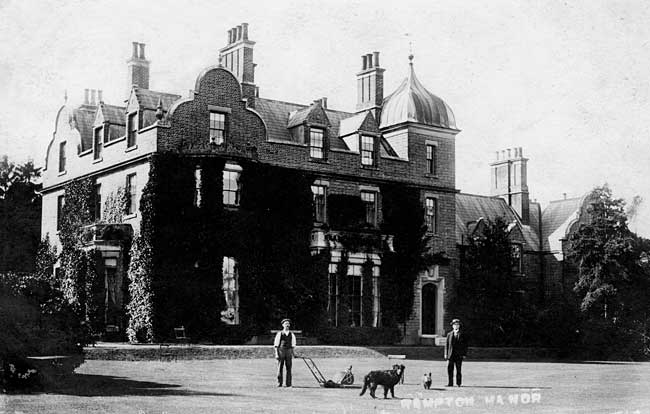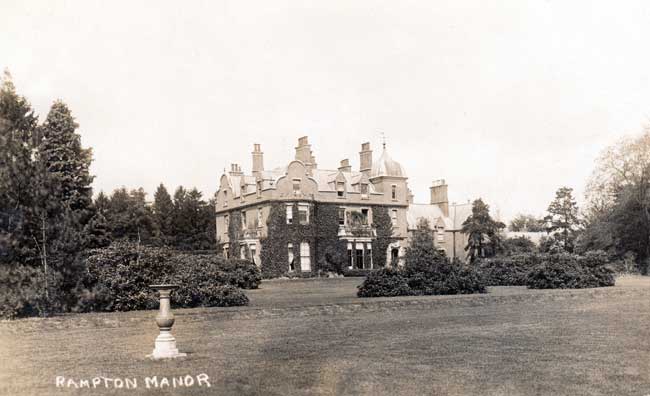< Papplewick | Contents | Rufford >
Rampton

Rampton Manor from the south, c.1905.
IN the billiard room at Rampton Manor there are two standards which were the first things that Colonel Eyre showed to me, and of which he, as a distinguished soldier, may justly feel proud. Where and when the material of which they are composed was woven it matters not, but it is interesting to know that they were once uplifted in battle, and were waved by the enemy at the siege of Lucknow, when
Handful of men as we were, we were English in heart and in limb,
Strong with the strength of the race to command, to obey, to endure.
The presence of such trophies as these in a quiet peaceful mansion in the corner of an English county, and the property of an English country gentleman, is not common. In this case they suggest something of family history and ancestral proclivity. These discoloured banners, the fabric of which had been pierced by the bullets of those who fought each one as if “hope for the garrison hung but on him,” (to use again the stirring words of the Laureate,) were captured by a company of the Second Rifle Brigade, in which Colonel Eyre was an officer. You would hardly think that the gently-courteous country gentleman, full of vigorous activity, whose conversation runs upon the arts- of peace, and only occasionally upon political warfare, had seen so much active and exciting service, had been wounded in the service of his country, and had been decorated with medals of which any brave man might well be proud. Colonel Eyre has carried arms for nearly thirty years, including the period during which he has had the command of one of the volunteer regiments of this county. He fought in the Crimea; he was wounded at the attack of the Redan; he served during the Indian Mutiny, was present at the siege and fall of Lucknow, and was present with Ross’s camel corps at the fall of Calpee. A man who has been mixed up with events like these knows something of the horrors of war, and can appreciate the peace and tranquility of an English country life, to which certain duties and responsibilities are attached.
The Eyres may be described as a family of soldiers. In the early years of his service, Colonel Eyre was attached to the staff of his relative, Lieut.-General Sir William Eyre, in the capacity of aide-de-camp, and he can look back with pride upon a line of ancestors who have been skilled in the use of arms, and who have attained distinguished positions in the service. Sir Gervase Eyre was a commander of forces in the reign of one of the Charleses, and was killed in the defence of Newark Castle in the early part at the seventeenth century; and the descendant of this distinguished officer, Sir George Eyre, K.C.B., held an important command. Anthony Hardolph Eyre, the, representative of an after generation, was also a lieut.-colonel in the army; and another of Colonel Eyre’s lineal ancestors, in the First Foot Guards, was killed at the Battle of Barossa, in Spain, in 1811. To the memory of several of these distinguished representatives of an ancient line there are tablets on the walls of Rampton Church. From this it will be gathered that Colonel Eyre, the gallant commander of the North Notts. Rifle Volunteers, comes of a warlike stock. Of his own honourable connection with the profession of arms there are evidences at Rampton which his guests may see. In his little room where books and papers are kept, there are a number of trifles brought from the Redan and from Lucknow, some of them displayed on the same walls, as is a collection of admirable sepia and other drawings, representing highland sports and moorland scenery, which have been executed by Mrs. Eyre. Carefully framed and preserved from destroying influences is a slight sketch—a half finished trifle, but displaying remarkable artistic merit, which was rapidly outlined by an officer attached to Sir William Eyre’s staff at the moment the Zouaves were making their gallant attack on the Malakoff, in September, 1855, and representing that spirited movement. This the Colonel thinks much of, and he also takes scrupulous care of a tiny wooden cross—one of twenty that were made as the sad memorials of a cruel event. These were carved out of the wood of the door against which the heads of the unfortunate children were dashed by the murderous Sepoys, at Cawnpore, the blood stains of which massacre were seen by the holder of this small memorial of one of the most inhuman acts that ever darkened the pages of history. A photograph of the members of the 2nd Rifle Brigade, whose courage and fidelity their old lieutenant still speaks of, and small things brought from Lucknow, the Redan, and other fields of conflict, are carefully preserved by the owner of Rampton Manor. Years have passed away since the occurrence of those stirring events of which these small trophies remind one, and we find Colonel Eyre in middle life actively engaged in the affairs of the northern end of the county, and spending much of his time in the study of Imperial politics. Colonel Eyre may not unfitly be described as a practical politician. Many months ago now it occurred to him that taxation pressed unfairly upon landed property, and he is the founder of an association—the first of the kind which has existence in the county, whose object it is to get the taxation more equally distributed amongst those who, though they get the lions share of the benefits and conveniences for which the taxes are levied, contribute little or nothing to their maintenance or support.
Colonel Eyre may indeed justly claim to rank among the pioneers of ratal reform. And it is more than possible that he will live to see his very fair and modest proposals carried into effect. As a magistrate of the bounty, and as a member of various public bodies, Colonel Eyre, renders most useful service, and his advice upon all matters of county administration is always valuable.
The family of which Colonel Eyre is the head is undoubtedly one of the oldest, if not the oldest, in the county. There has been an Eyre at Rampton for more than two hundred years; and beyond that period the Eyres were possessed of land in Derbyshire to a very considerable extent. In the pages of a very able work recently published by Mr. J. C. Cox, on the churches of Derbyshire, the Eyres are mentioned over and over again, and memorials of them are scattered up and down that county in considerable profusion. In the reign of Henry the Third, a certain William Le Eyr had a residence at Hope, in the Peak district, held lands of the King in capite, and had to do with the custody of the forests of the High Peak. His ancestor married one of the co-heiresses of George Hercy, the lord of Grove, in Nottinghamshire, and that fine mansion, now the residence of the Harcourt-Vernons, was once the principal seat of the Eyres. Rampton was originally, after the Conquest, the property of Roger do Busli, who seems to have acquired enormous slices of land up and down the county, and before it came into the hands of the Eyres it belonged to the Stanhopes, the Malovels, and the Babingtons. In the reign of James the First, Sir Gervase Eyre, who was commander of the horse, and was slain whilst defending Newark Castle on behalf of his Sovereign, Charles the First, married the co-heiress of John Babington, and by this marriage Rampton came to his descendants, who have held it since. I have already mentioned several of the Eyres who were distinguished in arms. Members of the family have at various periods represented the county in Parliament; their sons and daughters have at different times married into noble and titled families, and their armorial bearings contain no fewer than five-and-twenty quarterings. The chancel of Rampton Church is filled with mural monuments to the memory of different members of the family, which included an archdeacon of Nottingham; and in the churches of Derbyshire you may find numerous records of them. At Rowton, in the neighbouring county, they had at one time a mansion, and about 1700, one of them built a chapel near his residence, and made his kinsman, Gervase Eyre, of Rampton, his heir “on condition of his constantly residing at Rowton, where he was to maintain a good house and sober hospitality.”

Rampton Manor, c.1920.
Rampton Manor, as it appears to-day, in bold, well-defined Elizabethan proportions, situated in the midst of rich pasture land, and unobscured by any wealth of foliage, does not suggest antiquity. It is a handsome modern brick mansion, built thirty years ago, by an eminent architect, and at considerable cost. Its predecessor was built in the reign of the Eighth Henry, but was pulled down more than a century and a half ago. The only trace of the old hall remaining, is an oak shield or panel, on which are carved the arms and crest of the Eyres. This solitary and somewhat modest relic of the old family residence, now hangs over the doorway in one of the lower apartments at Rampton, where there are a number of glass cases containing rare birds of brilliant plumage, which have been shot in different parts of the world, by Colonel Eyre. The principal rooms are bright, and the prospects are cheerful, though the general formation of the country is flat. A mile away, the Trent flows along a broad and bending channel, and a stone thrown across the river falls in Lincolnshire, where, close to the water’s edge, are the ruined and turreted walls of what is said to have been a castle. In front of this dismantled brickwork, which once formed part of a substantial and pretentious residence, the Trout flows through green meadows, kept within bounds on the Nottinghamshire side by a sturdy and continuous embankment, which is of great use when the river is swollen by heavy rains. Rampton Manor is said to occupy an elevated position, though this is hardly apparent to one sitting in the comfortable dining room, and looking over the park and meadow land, which spreads away towards the river. In summer, when everything is in full life, the scenery is pretty about here, and one would say that the manor was well situated. Inside, it is very comfortable—filled with bright objects and cheerful furniture, and one realises what is implied by that sober and genuine hospitality which was enjoined upon the owner’s ancestors nearly two centuries ago.
In the dining room there are a few good pictures; in the drawing room are several excellent copies of old masters. Among these is a striking copy of Murillo’s “Children of the Shell,” which was executed by an artist Colonel Eyre had met in Rome. There are also admirable copies of two well-known works by Guido and Albert Durer, which, with other pictures in the drawing room, overlook some choice pieces of Sevres China. Among the dining room collection are two interesting landscapes, by Salvator Rosa. Originally they are supposed to have formed one large picture, which some former possessor divided into two parts, a division which increased the collection to which they belonged, and affected a companionship which has not marred the conception of the painter, or caused any mutilation of his work. They are parts of a mountain scene, into one half of which figures are introduced, the central one an astrologer or seer, who, with outstretched arms, appears to be invoking some spirit of the mountain. The picture is a good example of Salvator’s comprehensive genius and lively poetic imagination, and the attitudes and actions of the figures are natural and full of dignity. In another part of the room there is a characteristic painting by Bloemart – a cook engaged in trussing a fowl; and there are good examples of the work of Van der Docs- probably Simon of that name, and of Van Diest, the last-named in two small frames, with herons and dogs upon a few inches of canvas. There are, besides, a fruit piece and a Dutch painting without a name, making up a small, but interesting, collection. In these old houses of the county one generally sees what is good in the way of pictures. If they are modern pictures, they are well chosen; if they are old, while they tell no tale of artistic taste bearing upon their owner, they say something at least for his ancestors, and form a hidden contribution to the art treasures of the country.
< Papplewick | Contents | Rufford >
